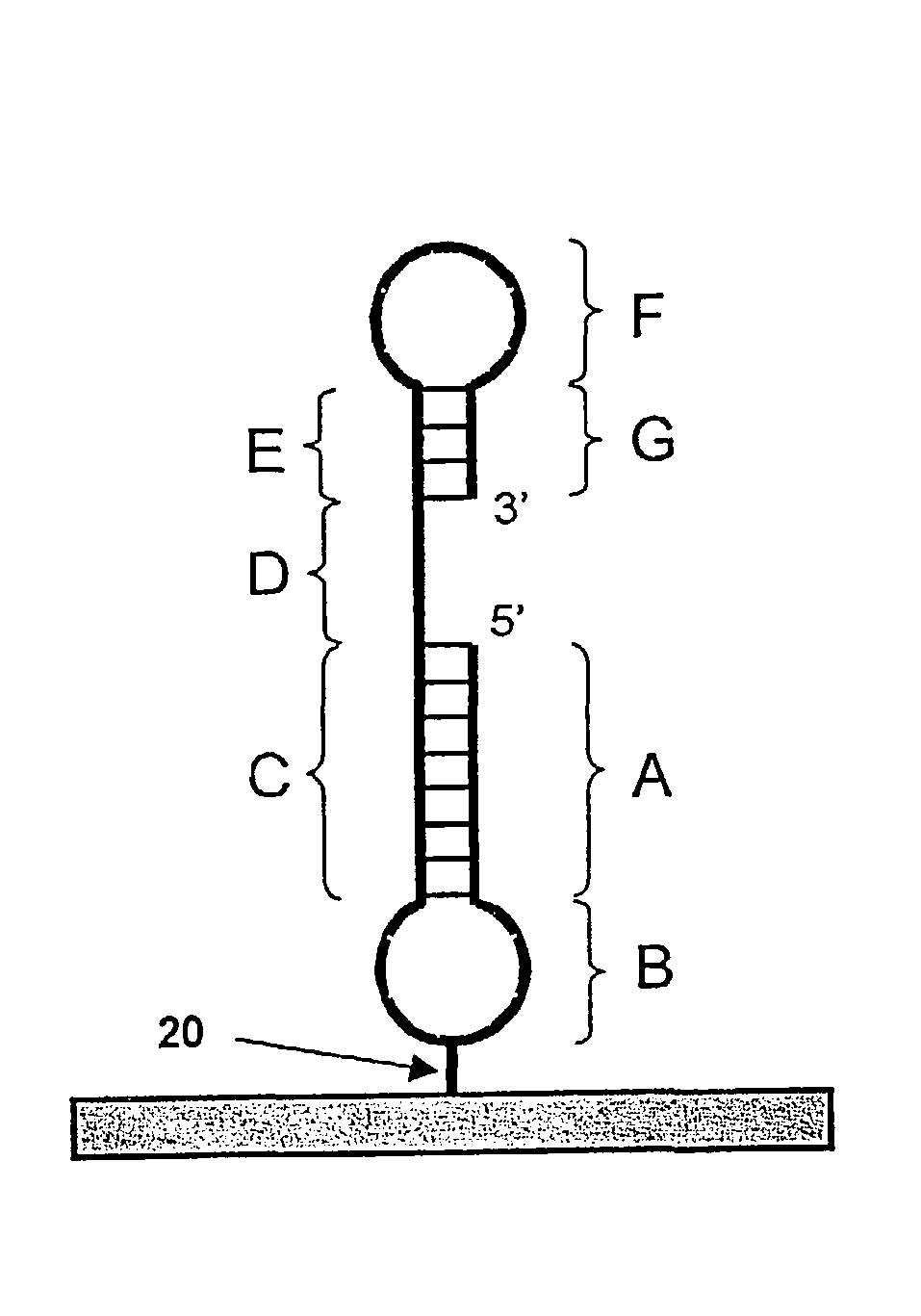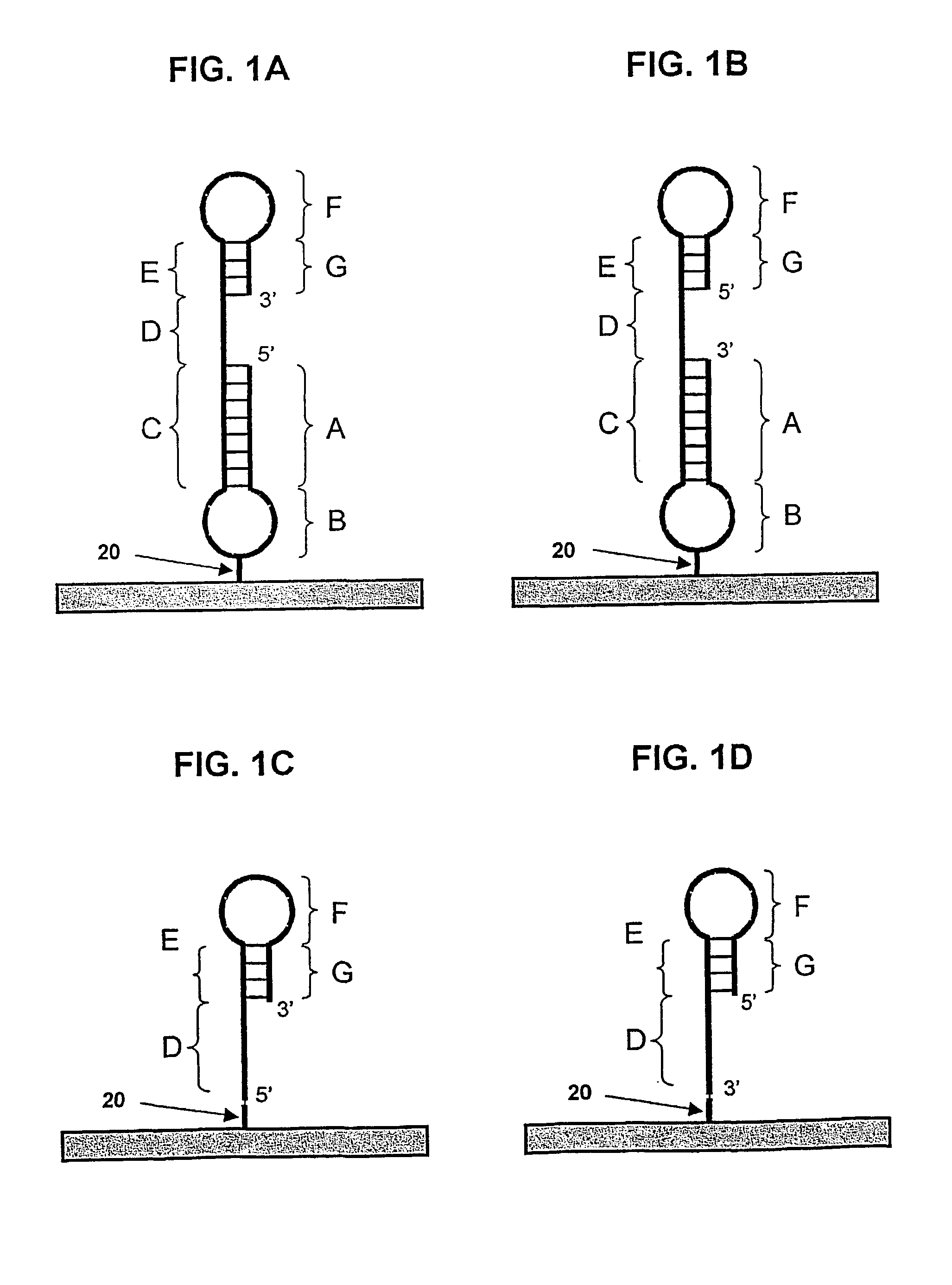Capture moieties for nucleic acids and uses thereof
a nucleic acid and moiete technology, applied in the field of molecules, can solve the problems of linear probe sequences, inability to capture moieties, and inability to amplify undesired analytes,
- Summary
- Abstract
- Description
- Claims
- Application Information
AI Technical Summary
Benefits of technology
Problems solved by technology
Method used
Image
Examples
example 1
[0178]Probes having SEQ ID NOs:1 and 2 (Table 1) were tested to determine their relative abilities in discriminating between molecules having SEQ ID NOs:3 to 13 (Table 1).
[0179]The structure of the probe having SEQ ID NO:1 is shown schematically in FIG. 1A, and in greater detail in FIG. 2A. The probe has two hairpins. The duplex of the first hairpin (regions A and C in FIG. 1A) contains sixteen base pairs and the paired regions are linked by five thymidine residues (region B in FIG. 1A). The central thymidine is biotinylated and forms a link 20 to solid support 22. The remainder of the probe corresponds to regions D-E-F-G of the FIG. 1A schematic. The duplex region of the second hairpin is six base pairs in length (regions E and G of FIG. 1A). The target-binding sequence (D-E-F of FIG. 1A) is sixteen bases in length. The first hairpin is relatively stable in comparison to the second hairpin based on a comparison of calculated Tm values for the sixteen base-pair stem (more stable dup...
example 2
[0185]In this example, probes having SEQ ID NOs:1 and 14 (Table 1) were tested to determine their relative abilities in discriminating between molecules that have SEQ ID NOs:6 to 11 (Table 1).
[0186]The structure of the probe having SEQ ID NO:1 is shown schematically in FIG. 1A and in greater detail in FIG. 2A, and its various features are described in Example 1.
[0187]The structure of the probe having SEQ ID NO:14 is similar to the schematic shown in FIG. 1C. It is similar to the probe having SEQ ID NO:1, but is lacking the first 19 bases, corresponding to region A and three bases of B of SEQ ID NO:1. This probe thus includes region C-D-E-F-G and does not have a hairpin at its 5′-end. Two additional 5′-terminal thymidines, one of which is biotinylated for anchoring to a solid support.
[0188]The protocol outlined in Example 1 was followed with probes having SEQ ID NOs:1 and 14 with targets having SEQ ID NOs:3 and 6 to 11. The results are shown in FIG. 4. In this case, net RLUs (relativ...
example 3
[0190]Probes having SEQ ID NOs:15 and 16 (Table 1) were tested to determine their relative abilities in discriminating between molecules having SEQ ID NOs:4 to 13 and 17 (Table 1).
[0191]Probes having SEQ ID NOs:15 and 16 have the same sequences as probes having SEQ ID NOs:1 and 2, respectively, except that the third and fourteenth bases of the target-binding sequence have each been changed from A to T. This means that each of the nucleic acid molecules having SEQ ID NOs:4 to 13 contain three mismatches with respect to the probes having SEQ ID NOs:15 and 16. SEQ ID NO:17 is the matching complement to the target-binding sequence of these probes. The percent identity between the perfect match and each of molecules having SEQ ID NOs:4 to 13 is thus 13 / 16=81.25%.
[0192]The protocol outlined in Example 1 was again followed, except that in this case each target molecule (SEQ ID NOs:4 to 13 and 17) was added such to a final concentration of 0.5 pmol / well as opposed to the 0.05 pmol / well quan...
PUM
| Property | Measurement | Unit |
|---|---|---|
| temperature | aaaaa | aaaaa |
| pH | aaaaa | aaaaa |
| length | aaaaa | aaaaa |
Abstract
Description
Claims
Application Information
 Login to View More
Login to View More - R&D
- Intellectual Property
- Life Sciences
- Materials
- Tech Scout
- Unparalleled Data Quality
- Higher Quality Content
- 60% Fewer Hallucinations
Browse by: Latest US Patents, China's latest patents, Technical Efficacy Thesaurus, Application Domain, Technology Topic, Popular Technical Reports.
© 2025 PatSnap. All rights reserved.Legal|Privacy policy|Modern Slavery Act Transparency Statement|Sitemap|About US| Contact US: help@patsnap.com



